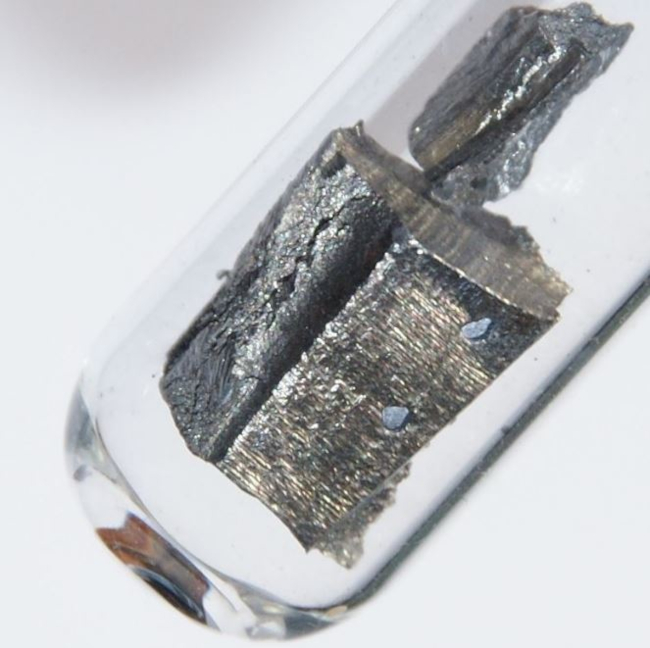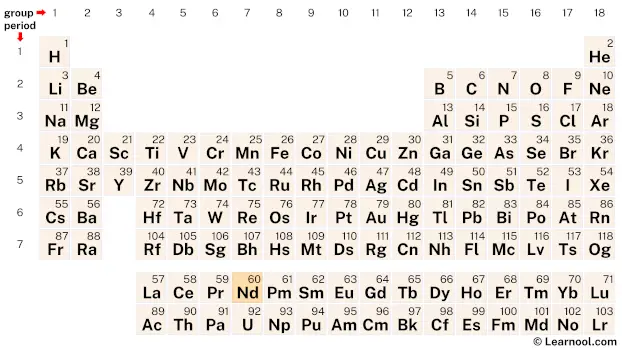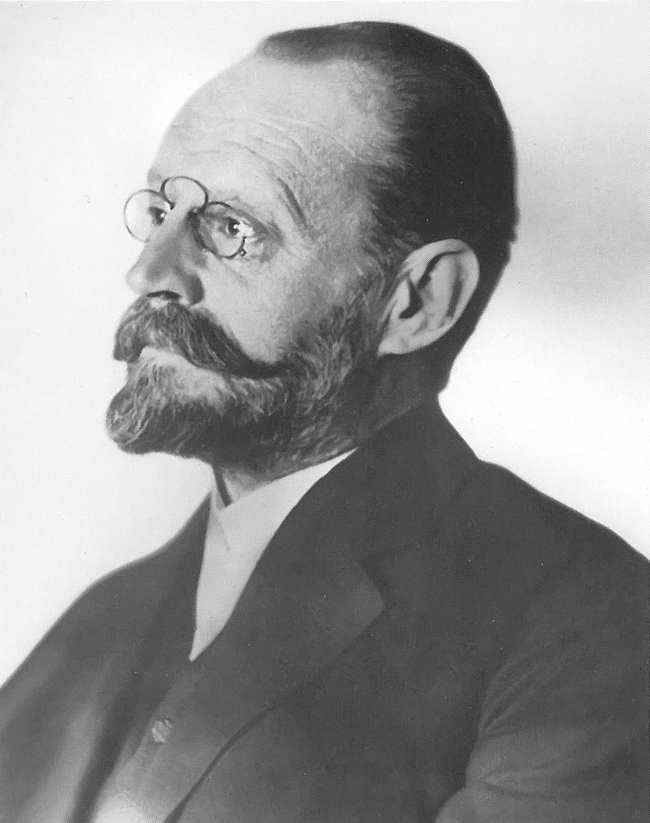
Neodymium (Nd) is a chemical element of the periodic table, located in the period 6, and has the atomic number 60. It is the fourth element in the lanthanide series. It is a soft, bright, silvery-white metal, whose name comes from the Greek word “neos didymos”, which means new twin. It is a highly reactive metal and is counted as one of the rare earth elements.
On periodic table
| group | ⇨ | 1 | 2 | 3 | 4 | 5 | 6 | 7 | 8 | 9 | 10 | 11 | 12 | 13 | 14 | 15 | 16 | 17 | 18 |
| period | ⇩ | ||||||||||||||||||
| 1 | 1 H  Hydrogen |
2 He  Helium |
|||||||||||||||||
| 2 | 3 Li  Lithium |
4 Be  Beryllium |
5 B  Boron |
6 C  Carbon |
7 N  Nitrogen |
8 O  Oxygen |
9 F  Fluorine |
10 Ne  Neon |
|||||||||||
| 3 | 11 Na  Sodium |
12 Mg  Magnesium |
13 Al  Aluminium |
14 Si Silicon |
15 P  Phosphorus |
16 S  Sulfur |
17 Cl  Chlorine |
18 Ar  Argon |
|||||||||||
| 4 | 19 K  Potassium |
20 Ca  Calcium |
21 Sc  Scandium |
22 Ti  Titanium |
23 V  Vanadium |
24 Cr  Chromium |
25 Mn  Manganese |
26 Fe  Iron |
27 Co  Cobalt |
28 Ni  Nickel |
29 Cu  Copper |
30 Zn  Zinc |
31 Ga  Gallium |
32 Ge  Germanium |
33 As  Arsenic |
34 Se  Selenium |
35 Br  Bromine |
36 Kr  Krypton |
|
| 5 | 37 Rb  Rubidium |
38 Sr  Strontium |
39 Y  Yttrium |
40 Zr  Zirconium |
41 Nb  Niobium |
42 Mo  Molybdenum |
43 Tc  Technetium |
44 Ru  Ruthenium |
45 Rh  Rhodium |
46 Pd  Palladium |
47 Ag  Silver |
48 Cd  Cadmium |
49 In  Indium |
50 Sn  Tin |
51 Sb  Antimony |
52 Te  Tellurium |
53 I  Iodine |
54 Xe  Xenon |
|
| 6 | 55 Cs  Caesium |
56 Ba  Barium |
72 Hf  Hafnium |
73 Ta  Tantalum |
74 W  Tungsten |
75 Re  Rhenium |
76 Os  Osmium |
77 Ir  Iridium |
78 Pt  Platinum |
79 Au  Gold |
80 Hg  Mercury |
81 Tl  Thallium |
82 Pb  Lead |
83 Bi  Bismuth |
84 Po  Polonium |
85 At  Astatine |
86 Rn  Radon |
||
| 7 | 87 Fr  Francium |
88 Ra  Radium |
104 Rf  Rutherfordium |
105 Db  Dubnium |
106 Sg  Seaborgium |
107 Bh  Bohrium |
108 Hs  Hassium |
109 Mt  Meitnerium |
110 Ds  Darmstadtium |
111 Rg  Roentgenium |
112 Cn  Copernicium |
113 Nh  Nihonium |
114 Fl  Flerovium |
115 Mc  Moscovium |
116 Lv  Livermorium |
117 Ts  Tennessine |
118 Og  Oganesson |
||
| 57 La  Lanthanum |
58 Ce  Cerium |
59 Pr  Praseodymium |
60 Nd Neodymium |
61 Pm  Promethium |
62 Sm  Samarium |
63 Eu  Europium |
64 Gd  Gadolinium |
65 Tb  Terbium |
66 Dy  Dysprosium |
67 Ho  Holmium |
68 Er  Erbium |
69 Tm  Thulium |
70 Yb  Ytterbium |
71 Lu  Lutetium |
|||||
| 89 Ac  Actinium |
90 Th  Thorium |
91 Pa  Protactinium |
92 U  Uranium |
93 Np  Neptunium |
94 Pu  Plutonium |
95 Am  Americium |
96 Cm  Curium |
97 Bk  Berkelium |
98 Cf  Californium |
99 Es  Einsteinium |
100 Fm  Fermium |
101 Md  Mendelevium |
102 No  Nobelium |
103 Lr  Lawrencium |
|||||
| – f block |
Neodymium (Nd) is located on the periodic table in the lanthanide series, which is a group of elements located at the bottom of the table. Specifically, in period 6, between praseodymium (Pr) and promethium (Pm).
Element information
 |
|
 |
|
| Origin of name | Greek word “neos didymos” (which means new twin) |
| Symbol | Nd |
| Atomic number (Z) | 60 |
| Atomic mass | 144.242 u |
| Block | f-block |
| Period | 6 |
| Classification | Lanthanide |
| Atomic radius | 181 pm |
| Covalent radius | 201±6 pm |
| Melting point | 1024 ℃, 1875 ℉, 1297 K |
| Boiling point | 3074 ℃, 5565 ℉, 3347 K |
| Electron configuration | [Xe] 4f4 6s2 |
| Learn how to write: Neodymium electron configuration | |
| Electrons per shell | 2, 8, 18, 22, 8, 2 |
| Learn how to draw: Neodymium Bohr model | |
| Crystal structure | Double hexagonal close-packed (dhcp) |
| Phase at r.t | Solid |
| Density near r.t | 7.01 g/cm3 |
| Main isotopes | Neodymium-142, Neodymium-143, Neodymium-145, Neodymium-146, Neodymium-148 |
| Natural occurrence | Primordial |
| Oxidation state | +3 |
| Electronegativity (Pauling scale) | 1.14 |
| Protons Neutrons Electrons |
60 84 60 |
| CAS number | 7440-00-8 |
| Discovered by | Carl Auer von Welsbach in 1885 |
History

Neodymium was first discovered in 1885 by the Austrian chemist Carl Auer von Welsbach. He was investigating a newly discovered mineral from Sweden called didymium, which was believed to be a single element. However, von Welsbach was able to isolate two new rare earth elements from didymium: praseodymium and neodymium.
Neodymium was named after the Greek words “neos,” meaning new, and “didymos,” meaning twin, as it was originally believed to be a twin of the element didymium. It wasn’t until 1925 that neodymium was shown to be distinct from didymium.
Since its discovery, neodymium has been used in various industrial applications, particularly in the production of powerful magnets. In the 1980s, researchers discovered that alloys of neodymium, iron, and boron could produce magnets significantly stronger than any previously known magnets. Today, neodymium magnets are used in a wide range of applications, including in computer hard drives, wind turbines, and electric vehicles.
Occurrence and production
Neodymium is one of the most abundant of the rare earth elements, with an abundance of about 38 parts per million in the Earth’s crust. Neodymium is typically found in minerals such as monazite and bastnäsite, as well as in some iron and titanium ores. The process of extracting neodymium from these minerals involves a complex series of steps, including grinding, acid leaching, solvent extraction, and precipitation.
The majority of neodymium production takes place in China, which accounts for over 80% of the world’s neodymium supply. Other significant producers include the United States, Australia, and Russia. The production of neodymium is primarily driven by its use in the production of neodymium magnets, which are used in a wide range of applications, including wind turbines, electric vehicles, and consumer electronics. As such, neodymium is an important strategic material for many countries.
Properties
Neodymium is a soft, silvery-white metal that belongs to the lanthanide series of elements.
It has a relatively high melting point of 1024 ℃ and a boiling point of 3074 ℃.
Neodymium is highly reactive and can quickly tarnish in air, forming an oxide layer on the surface.
Its atomic number is 60, and its atomic weight is 144.242 g/mol.
Neodymium is a paramagnetic material, which means it is attracted to magnetic fields and can be used to create strong permanent magnets.
It has a high heat capacity and can also be used in the production of specialized glass for high-powered lasers.
Applications
Permanent magnets
Neodymium magnets are the strongest type of permanent magnet available and are used in a wide range of applications including electric motors, hard drives, headphones, and speakers. These magnets have high magnetic energy and are able to maintain their magnetization over a long period of time.
Glass colorant
Neodymium is also used as a glass colorant, particularly in high-quality glasses used for optics and lasers. Neodymium-doped glass filters out yellow and green light, resulting in a pink or purple coloration.
Catalysts
Neodymium is used as a catalyst in the production of synthetic rubber and in the cracking of petroleum products. It is also used in the production of high-performance magnets and alloys.
Lighting
Neodymium is used in lighting, particularly in incandescent light bulbs and compact fluorescent bulbs. It is added to the glass to filter out yellow light, resulting in a whiter and more natural-looking light.
Nuclear reactors
Neodymium-147 is a radioactive isotope that can be used as a neutron absorber in nuclear reactors. It helps control the rate of nuclear fission by absorbing excess neutrons.
Jewelry
Neodymium is used as a component in some types of jewelry, particularly in colored diamonds. When added to the diamond, neodymium can give it a blue or violet coloration.
Interesting facts
Neodymium is named after the Greek words “neos” and “didymos,” which translate to “new twin,” referencing its discovery as a twin of the previously discovered element praseodymium.
It is one of the five rare earth elements used to make the powerful neodymium magnets that are used in many modern applications.
Neodymium is used in the glass industry to create a purple color in glass and as a component in welding goggles to protect against infrared light.
It is also used in various medical imaging applications, such as magnetic resonance imaging (MRI) and Positron Emission Tomography (PET) scans.
Neodymium is a key component in the production of high-efficiency motors used in electric vehicles and wind turbines.
The element has the potential to be used in the development of future technologies such as quantum computing due to its unique electronic properties.
Related
More elements
External links
- https://www.rsc.org/periodic-table/element/60/neodymium
- https://en.wikipedia.org/wiki/Neodymium
- https://www.britannica.com/science/neodymium
- https://www.acs.org/content/acs/en/greenchemistry/research-innovation/endangered-elements/neodymium.html
- https://www.chemicool.com/elements/neodymium.html
- https://pubchem.ncbi.nlm.nih.gov/element/Neodymium
- https://www.livescience.com/37656-neodymium.html
Deep
Learnool.com was founded by Deep Rana, who is a mechanical engineer by profession and a blogger by passion. He has a good conceptual knowledge on different educational topics and he provides the same on this website. He loves to learn something new everyday and believes that the best utilization of free time is developing a new skill.
